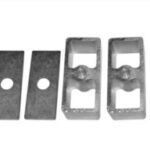The P0303 Code is a common diagnostic trouble code (DTC) that indicates a misfire in cylinder number three of your engine. This article will delve into the meaning of the P0303 code, its potential causes, associated symptoms, and how to diagnose and fix the problem. Understanding this code can help you address the issue promptly and prevent further damage to your vehicle.
A P0303 code indicates a misfire detected in cylinder 3. This could be due to various issues, from spark plugs to fuel injectors.
What Does the P0303 Code Mean?
The P0303 code is a generic OBD-II (On-Board Diagnostics) trouble code that signifies a misfire detected in cylinder number three. When your car’s computer, the Engine Control Module (ECM), detects a problem with the combustion process in this specific cylinder, it triggers the P0303 code and illuminates the check engine light. A misfire occurs when the air-fuel mixture in the cylinder fails to ignite properly, resulting in reduced engine power, rough running, and potentially increased emissions.
Common Symptoms of a P0303 Code
While the illuminated check engine light is the most obvious sign, other symptoms might accompany a P0303 code:
- Rough Engine Idle: The engine might vibrate excessively or run unevenly at idle.
- Engine Misfire: You might feel the engine stumble or hesitate, especially under acceleration.
- Reduced Engine Power: The car might feel sluggish and lack its usual power.
- Poor Fuel Economy: A misfiring cylinder can lead to decreased fuel efficiency.
- Strong Fuel Smell: Raw fuel might be expelled through the exhaust, resulting in a noticeable fuel odor.
Causes of a P0303 Code
Several issues can trigger a P0303 code. Here are some of the most common culprits:
- Faulty Spark Plugs or Wires: Worn-out spark plugs or damaged spark plug wires can prevent the ignition of the air-fuel mixture.
- Bad Ignition Coil: A malfunctioning ignition coil can fail to provide the necessary spark for combustion in cylinder three.
- Faulty Fuel Injector: A clogged or defective fuel injector can disrupt the proper delivery of fuel to the cylinder.
- Vacuum Leaks: Leaks in the intake manifold or vacuum hoses can disrupt the air-fuel ratio, leading to misfires.
- Low Compression: Low compression in cylinder three, often caused by worn piston rings or valves, can hinder proper combustion.
- Catalytic Converter Issues: A malfunctioning catalytic converter can sometimes cause misfires. A rotten egg smell from the exhaust is a common indicator of a bad catalytic converter.
Diagnosing and Fixing a P0303 Code
Diagnosing the root cause of a P0303 code often requires a systematic approach:
-
Read the Code: Use an OBD-II scanner to confirm the P0303 code and check for any other related codes.
-
Inspect Spark Plugs and Wires: Visually inspect the spark plugs and wires for damage or wear. Replace them if necessary.
-
Check Ignition Coil: Test the ignition coil for proper function using a multimeter or a dedicated coil tester.
-
Inspect Fuel Injector: Check the fuel injector’s resistance and spray pattern. Consider cleaning or replacing it if necessary.
-
Test for Vacuum Leaks: Use a vacuum gauge or a smoke machine to detect any vacuum leaks.
-
Perform a Compression Test: Measure the compression in cylinder three to assess the condition of the piston rings and valves.
Using an OBD-II scanner can help pinpoint the problem causing the P0303 code.
Conclusion
Addressing a P0303 code promptly is crucial to prevent further engine damage and ensure optimal vehicle performance. While some fixes, like replacing spark plugs, can be handled by DIYers, more complex issues might require the expertise of a qualified mechanic. If you are unsure about any step of the diagnostic or repair process, it’s always best to consult a professional.

